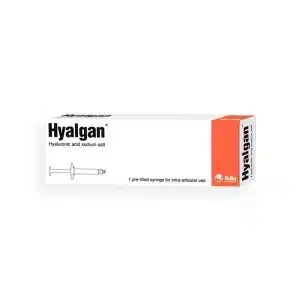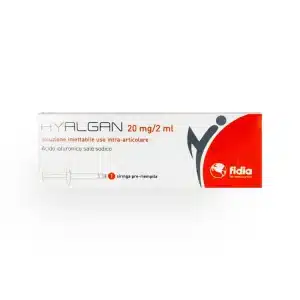Osteoarthritis (OA) affects 54.4 million adults in the United States, with the knee being the most commonly impacted joint. The breakdown of synovial fluid within the joint contributes significantly to OA’s debilitating effects. Fortunately, treatments like viscosupplementation offer relief by injecting hyaluronic acid into affected joints to restore this crucial fluid.
Hyalgan is a synovial fluid replacement therapy that acts as a lubricant and shock absorber in the knee joint. It serves as an alternative treatment when painkillers or exercise are insufficient. Derived from purified hyaluronic acid extracted from rooster combs, Hyalgan helps restore the joint’s natural fluid balance, easing pain and improving mobility.
In this article, we explore the science behind Hyalgan, its benefits, and potential side effects to help you make informed decisions about your treatment.
Key Takeaways
- Common side effects of Hyalgan include localized pain, swelling, and redness at the injection site, which usually goes away within a few days to a week.
- Management of common side effects involves using ice packs, taking them easily for a couple of days, and, if necessary, using over-the-counter pain relief like acetaminophen.
- Rare but severe side effects of Hyalgan include infections and allergic reactions, which require quick action and immediate medical attention.
- Short-term side effects of Hyalgan include immediate post-injection discomfort and short-term inflammation, which can be managed by applying ice to the area and avoiding complex activities for a couple of days.
- Long-term benefits of Hyalgan include potential long-term relief from knee pain due to osteoarthritis.
About: Medical Spa RX provides medical practices with premium products at the best prices. If you’re looking to buy Hyalgan for your practice, the sales representatives at Medical Spa RX can give you guidance.
Hyalgan Side Effects – What to Expect After Treatment
Osteoarthritis (OA) affects 54.4 million adults in the United States, with the knee being the most commonly impacted joint. The breakdown of synovial fluid within the joint contributes significantly to OA’s debilitating effects. Fortunately, treatments like viscosupplementation offer relief by injecting hyaluronic acid into affected joints to restore this crucial fluid.
Hyalgan is a synovial fluid replacement therapy that acts as a lubricant and shock absorber in the knee joint. It serves as an alternative treatment when painkillers or exercise are insufficient. Derived from purified hyaluronic acid extracted from rooster combs, Hyalgan helps restore the joint’s natural fluid balance, easing pain and improving mobility.
In this article, we explore the science behind Hyalgan, its benefits, and potential side effects to help you make informed decisions about your treatment.
Key Takeaways
- Common side effects of Hyalgan include localized pain, swelling, and redness at the injection site, which usually goes away within a few days to a week.
- Management of common side effects involves using ice packs, taking them easily for a couple of days, and, if necessary, using over-the-counter pain relief like acetaminophen.
- Rare but severe side effects of Hyalgan include infections and allergic reactions, which require quick action and immediate medical attention.
- Short-term side effects of Hyalgan include immediate post-injection discomfort and short-term inflammation, which can be managed by applying ice to the area and avoiding complex activities for a couple of days.
- Long-term benefits of Hyalgan include potential long-term relief from knee pain due to osteoarthritis.
About: Medical Spa RX provides premium products at the best prices for medical practices. If you’re looking to buy Hyalgan wholesale for your practice, the sales representatives at Medical Spa RX can give you guidance.
Common Side Effects of Hyalgan
- Localized Pain: Localized pain at the injection site is a common side effect people get from Hyalgan. This process means after getting the shot, you might feel pain right where it was given. This pain happens to a lot of patients. They also see swelling and redness around that area.
- Swelling and Redness: After getting Hyalgan, swelling and redness at the injection site are common. This happens because your body is reacting to the treatment. Many people also feel pain and warmth there and might see some bruising. It’s normal but should not last long.
To manage these side effects, applying a cold compress to the affected area can help reduce swelling and alleviate discomfort. Over-the-counter pain relievers, such as acetaminophen, can also be used if needed.
In short-term care after getting Hyalgan, taking simple steps can make patients more comfortable as their body adjusts to the treatment. People often monitor the side effects and may compare treatments, like Hyalgan vs Supartz, to see which product is more beneficial to them.
Rare but Serious Side Effects of Hyalgan
While Hyalgan is generally well-tolerated, there are rare but serious side effects that patients should be aware of.
- Infections at the Injection Site: Although uncommon, infections can occur at the injection site. Signs of infection include increased redness, warmth, swelling, and the presence of pus. If you notice these symptoms, seeking medical attention immediately is crucial, as infections may require prompt treatment with antibiotics.
- Allergic Reactions: Rarely, some individuals may experience an allergic reaction to Hyalgan. Symptoms can include severe itching, rash, swelling (especially of the face, tongue, or throat), dizziness, and difficulty breathing. An allergic reaction requires immediate medical intervention, as it can be life-threatening.
To manage these rare side effects, it’s important to closely monitor your body’s response after receiving a Hyalgan injection. If you experience any symptoms that suggest an infection or allergic reaction, contact your healthcare provider right away. Early identification and treatment are key to preventing more serious complications. Always inform your doctor about any allergies or previous reactions to injections before starting Hyalgan therapy.
Short-Term Side Effects of Hyalgan
- Immediate Postinjection Discomfort: Following a Hyalgan injection, patients may experience immediate discomfort at the injection site. This can manifest as pain, swelling, redness, warmth, or bruising. These symptoms are typically mild and occur due to the needle insertion and the body’s initial reaction to the injected substance.
- Short-term Inflammation: In some cases, the injected joint may exhibit short-term inflammation. This can include increased joint fluid buildup and a flare-up of inflammation. Such reactions are generally temporary and should subside within a few days.
The short-term side effects of Hyalgan usually resolve within a few days. To manage these side effects, patients can apply ice packs to the affected area, take over-the-counter pain relievers as their healthcare provider recommends, and avoid strenuous activities that may exacerbate the symptoms.
Long-Term Side Effects of Hyalgan
- Potential for Long-term Pain Relief: Hyalgan offers hope for long-term relief from knee pain due to osteoarthritis. This treatment can help patients move better and feel less pain. It usually takes up to three injections to see the full benefits of Hyalgan.
- Monitoring for Any Long-Term Complications: Patients getting Hyalgan shots should be monitored for long-term complications. This means watching their health closely and telling their doctor if they notice anything wrong. It is crucial to catch and deal with these issues early.
Patient Case Studies and Clinical Data on Longterm Effects
Several studies have highlighted Hyalgan’s long-term benefits and safety. For instance, a large U.S. clinical trial involving 495 patients demonstrated that Hyalgan provided effective pain relief for up to 26 weeks.
Another study showed that patients who received five injections experienced significant pain reduction compared to those who received fewer injections. Furthermore, long-term data suggest that Hyalgan can help delay the need for knee replacement surgery in some patients
Conclusion
Hyalgan is an effective treatment for knee pain caused by osteoarthritis, administered through injections directly into the knee joint. While some patients may initially experience increased pain or swelling, these symptoms typically subside. Though rare, more serious side effects like infections or allergic reactions can occur.
If you have concerns about potential side effects, it’s important to discuss them with your doctor. They can help manage any adverse reactions and ensure that you continue to benefit from the treatment.
FAQs
1. What is Hyalgan, and what does treatment involve?
Hyalgan is a medication for knee pain in joint inflammation or osteoarthritis patients. The treatment involves injecting the medicine directly into the knee joint.
2. Are there any side effects of Hyalgan treatment?
Yes, like most medications, Hyalgan can have side effects. These may include pain at the injection site, swelling, itching, headache, or nausea.
3. Is it normal to experience these side effects after treatment?
Some people experience these side effects after their Hyalgan treatment, but not everyone will have them. If you are concerned about symptoms following your injection, please consult your doctor immediately.
4. How long do these side effects last?
The duration of the side effects varies for each individual. Some might feel better within hours, while others may take a few days to recover fully from the discomfort caused by the injection.
References
Hyalgan. (2016). Patient information. Retrieved August 10, 2024, from https://hyalgan.com/wp-content/uploads/2016/05/HyalganPatInfoPDFupdate513.pdf
Bellamy, N., Campbell, J., Robinson, V., Gee, T., Bourne, R., & Wells, G. (2006). Viscosupplementation for the treatment of osteoarthritis of the knee. The Cochrane database of systematic reviews, 2006(2), CD005321. https://doi.org/10.1002/14651858.CD005321.pub2
Manfreda, F., Rinonapoli, G., Nardi, A., Antinolfi, P., & Caraffa, A. (2017). A Fatal Sepsis Caused by Hyaluronate Knee Injection: How Much the Medical History and the Informed Consent Might Be Important? Case reports in orthopedics, 2017, 1518401. https://doi.org/10.1155/2017/1518401




















